Protecting the Environment
A successful drilling waste management program that reduces operating costs
Seven areas of improvement were identified and carried out on 27 wells in three land drilling campaigns.
Mike Ward, Brunei Shell Petroleum; Jerrod Breaux, Brian Campbell and Simon Seaton, Baroid Surface Solutions/ Total Fluids Management
Brunei Shell Petroleum (BSP) has reduced the average cost of drilling fluids and waste management per meter drilled on land wells by 6.8%. This includes the additional cost of Halliburton's Total Fluids Management (TFM) engineering services (personnel and additional equipment). To improve solids control efficiency, gain control over drilling waste streams and ensure compliance with ISO-14001 requirements, BSP implemented the fluid management services in the Anduki, Rasau Land and Seria campaigns. Key performance indicators included volumes of fluid disposed (m3/m), TFM services' costs per meter drilled, HSE incidents and third-party costs.
The fluid management services are designed to address every aspect of the drilling fluid system: mud, personnel, chemical treatments, solids control optimization, water recovery and treatment, and drilling waste handling and transportation. In support of BSP operations, the fluid management team compiled and executed written procedures to identify waste streams and disposal options, including manifests to enable mass balance of waste volumes. These procedures were reviewed by the ISO audit team and accepted without changes.
The fluid management program features a centrally located wastewater treatment plant and the process for drying drill cuttings prior to landfill disposal. Fluid management personnel manned and operated the wastewater treatment plant. The drying facility was operated by a national third-party company, with volumes and logistics tracked and reported in the fluid management database.
Based on 12 months of operations encompassing 27 wells, BSP expects to save an average of $24,000 per rig per month through continued use of fluid management services. This savings includes the cost of full-time fluid management personnel on the rig, operation of the Anduki Wastewater Treatment Plant and Environmental Compliance Reporting.
TFM KEY OBJECTIVES
Historically, waste pits were used at land rig sites. At the end of each well the wet cuttings were dug out and trucked to landfill, where a significant cost was incurred as the cuttings were treated purely as waste material. Once the water-based mud could no longer be directly reused, it was disposed of by pumping from solids settling pits. This disposal also incurred significant cost and the polymers in the mud seriously disrupted the workings of the sewage plant used for fluids disposal. This led to remedial work being carried out to maintain the sewage works, and also meant that any prolonged shutdown of the plant could stop the drilling operation. A strategy was formed to turn the cuttings into a useful product no longer classified as waste and to find a better means of disposing liquid mud and brine.
BSP established three goals to be achieved by the introduction of fluid management services in the Anduki, Rasau Land and Seria campaign:
- Reduce drilling fluid costs through improved solids control efficiency and performance
- Improve waste stream tracking related to drilling operations
- Assist BSP in becoming ISO 14001 compliant.
The fluid management services were initially implemented on 12 wells over a six-month trial period. At the end of that interval, BSP had reduced overall drilling fluids and waste management cost per meter drilled on land wells by more than 30%, Fig. 1. The impact of these services was measured according to the key performance indicators (KPIs) in Table 1.
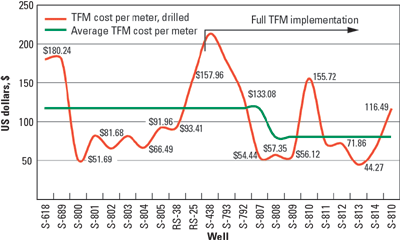 |
Fig. 1. Average cost/m (drilled) for fluid management services before and after full implementation.
|
|
| |
Table 1. Key performance indicators |
|
| |
Type of analysis |
KPI |
|
| |
|
|
| |
Volume (m3/m) |
Fluid disposed per meter drilled |
|
| |
|
Wastewater disposed per meter drilled |
|
| |
|
Mud consumption per meter drilled |
|
| |
|
|
|
| |
Cost ($US) |
TFM cost per meter drilled |
|
| |
|
Planned versus actual drilling fluid cost |
|
| |
|
Third-party charges |
|
| |
|
|
|
| |
Health, safety and environment |
Number of recordable incidents |
|
| |
|
Number of STOP cards produced |
|
| |
|
Transportation (km) |
|
|
To meet project goals, the team immediately implemented several changes and improvements at the wellsite, as shown in the following examples. All rig centrifuges were replaced with new units maintained by skilled technicians. A fully functioning wastewater treatment facility was installed to treat the waste stream from water-based fluids and return the treated water to the rig for reuse. Full-time, dedicated supervisors for these fluid management services were placed on several rigs to track and account for the waste streams, a step that strongly supported BSP's efforts to gain ISO 14001 certification.
VOLUME ANALYSIS AND REDUCTION
The fluid management representative reviewed the data collected by BSP each month on all wells, then correlated the information with data from each well to create a per well benchmark. The source for the BSP data was disposal manifests that broke out monthly volumes of fluid received for disposal. Full-time supervision by personnel resulted in a significant reduction in disposal volume per meter drilled, Fig. 2.
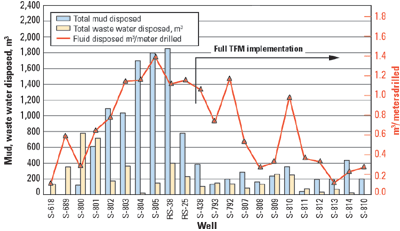 |
Fig. 2. Volume disposal per meter drilled before and after fluid management services.
|
|
The wastewater treatment plant was designed to treat water-based waste streams generated by a land rig and return the treated water for reuse. The treatment process included advanced flocculation techniques. At this time, the plant had received over 4,000 m3 of drilling waste, including drilling fluid, brine, wastewater and sludge from pit cleaning. From this 4,000 m3 of waste fluid, the Anduki plant produced 2,196 m3 of treated water. The rig was able to incorporate 244 m3 of this volume into the active drilling fluid system. The dense mixture of solids and water remaining after the treatment and removal of excess water through evaporation had the necessary properties for disposal to landfill.
The volumes of water-based and synthetic-based drilling fluid consumed were also reduced by applying these processes. By installing new, well-maintained centrifuges at each rig and closely monitoring surface and downhole volumes, as well as shaker performance, personnel were able to reduce mud consumption from an average 3.0 m3 per meter drilled during the first 10 wells, to an average of about 0.25 m3 per meter drilled on the 12 wells where TFM services were implemented, Fig. 3. These results also coincided with longer wells on average. Because every liter of water used on site needs to be trucked away, treated and disposed of, a reduction in water usage is also a critical success factor.
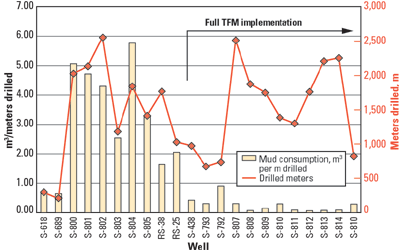 |
Fig. 3. Drilling fluid consumption per meter drilled.
|
|
ANALYSIS AND COMPARATIVE COSTS
The new fluid process addresses every aspect of the drilling fluid system. For these services to be cost effective, the savings in waste handling, disposal and prevention of non-compliance must be greater than the cost of maintaining the enhanced fluid services and associated personnel on the project.
The cost of these services to BSP was calculated on a per-meter-drilled basis (Fig. 4), and then analyzed in terms of actual versus planned drilling-fluid costs and a reduction in third-party charges. After complete fluid management services were established on the 12-well project, more than half were significantly under the planned drilling fluid cost, as compared to earlier wells where the actual cost exceeded planned cost most of the time, Fig. 5. Third-party charges also dropped after the introduction of full supervision by fluid management personnel. Results on Well S-808, shown in Table 2, demonstrate typical savings.
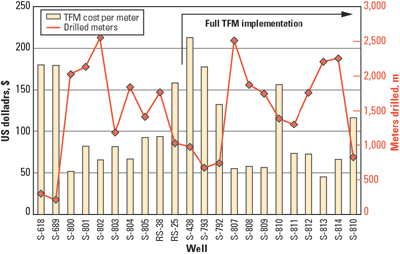 |
Fig. 4. TFM services cost per meter drilled.
|
|
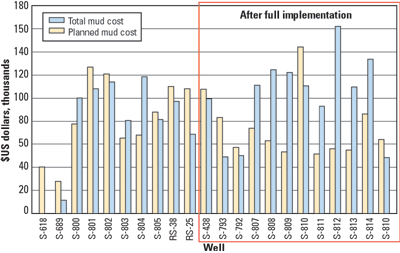 |
Fig. 5. Planned versus actual drilling fluid costs before and after fluid management services.
|
|
| |
Table 2. Managing fluid costs ($US) |
|
| |
Total TFM services cost on Well S-808 |
22,424 |
|
| |
|
Less: Reduction in third-party charges |
–3,750 |
|
| |
|
Savings between planned and actual drilling fluid |
–52,002 |
|
| |
Total savings resulting from fluid management services |
–33,328 |
|
|
IMPACT ON HSE
A reduction in waste volumes translated into fewer kilometers driven by third-party disposal services. BSP and the fluid management team agreed to a method for monitoring transportation kilometers as compared to target values. This documentation helps BSP reduce liability related to transportation.
Fluid management personnel demonstrated a commitment to safety throughout the project. Since commencing operations on the next land project, comprising 15 wells, the team has logged more than 13,000 man-hours with no recordable incidents. Fluid management representatives are also responsible for writing 372 STOP cards to help ensure continued safe operations.
GAINING ISO 14001
The comprehensive fluid management system maps out the appropriate activities to complete seven key processes: developing solutions, preparing resources, mobilizing resources, delivering services, demobilizing resources, completing reports, and reviewing performance. These services allow adaptation to specific circumstances and help maintain a focus on continuous improvement. As demonstrated in the project, the successful implementation of these services had a positive impact on drilling fluid costs, waste stream reduction, waste management cost reduction and a reduction in environmental liability for the operator.
Compliance with ISO 14001 procedural standards relies on accurate identification and tracking of all waste volumes and the correct disposal of waste streams. The written procedures and fit-for-purpose forms that support the fluid management process are designed to meet or exceed the requirements of regulatory agencies and ISO standards. In support of BSP's operations, the fluid management team compiled and executed written procedures to identify waste streams and disposal options, including manifests, to enable mass balance of waste volumes. These procedures were reviewed by the ISO audit team and accepted without changes.
IMPROVEMENTS AND ACHIEVEMENTS
Simply drying the cuttings by frequent turning in tropical sunlight can reduce the liquid content of the cuttings to less than 20%. Below this level, the cuttings can be used as capping material in the landfill and are received at no cost by the landfill operator. A low-cost drying operation thereby led to a huge reduction in classified waste as well as an economic benefit.
By means of a wastewater treatment plant utilizing flocculation and centrifuging, liquid mud can be reduced to clean brine and a solids stream. The centrifuged solids are mixed with the cuttings for drying. The clean brine can be injected into the produced water stream at the nearby crude oil terminal at no cost, other than for initial treatment in the wastewater treatment plant and transportation to the terminal. In addition, some of the regenerated brine can be used to build new mud, so that some recycling can take place.
The fluid team recommended and implemented a number of modifications to equipment and procedures. The examples shown below demonstrate the importance of educating each crew member and service company representative about his or her role in achieving better waste management performance. These examples also show how comprehensive the scope of the fluid management services is on a given project, ranging from software development to reconfigured rig equipment. The following improvements were achieved:
- Incorporated a tracking database for accurate accounting of processes for fluid movement, costs and other metrics that will help BSP with continued ISO 14001 compliance
- Reduced the volume of wastewater generated at the rig site through rig crew training
- Worked with onsite drilling fluids representative to monitor and optimize dilution rates, shaker screen usage and drilling fluid properties
- Equalized the surface mud system so that surface volume was reduced by about 40%
- Eliminated the need for solids control equipment wash water by installing hoses that wash the screens with drilling fluid rather than water
- Enabled effective offline centrifuging and the reclamation of used mud volumes, as well as centrifuging of the active system
- Supervised and confirmed daily maintenance of all solids control equipment to ensure maximum performance.
SUMMARY
Based on a year of operations encompassing 27 wells on land and offshore, BSP expects to save an average of $24,000 per rig per month through the continued use of TFM services. The key activities expected to generate this cost savings are:
- Waste stream minimization
- Close supervision of handling and disposal of drilling wastes
- Daily maintenance of solids control equipment by trained technicians
- Thorough training for rig crews and service personnel on waste stream reduction and management
- Compliance documentation.
In addition, performance measurement must be accurate so that there is continuous improvement. Only by constant evaluation and feedback can the surface mud system be optimized. 
THE AUTHORS
|
| |
Mike Ward joined Shell International as a drilling engineer in 1990 and has worked in positions from assistant driller to rig superintendent in areas such as Gabon, Vietnam, North Sea and Brunei. As rig superintendent for a land rig operation, he was particularly keen to reduce waste, HSE exposure and improve efficiency by critically reviewing and subsequently improving the whole waste management process. He works in The Hague as manager for Shell's Global Drilling Rig category.
|
|
Jerrod Breaux joined Baroid in 1991 as a total fluids management specialist. He has over eight years of oilfield experience, ranging from environmental regulatory compliance in the Gulf of Mexico, to waste management/ minimization in the South China Sea. Breaux administered the Baroid Surface Solutions program in Brunei to its completion.
|
|
Brian W. Campbell has more than 20 years' experience specializing in oilfield solids control and waste management. He joined Baroid in 1982, and in 1990 managed a specialist solids control company in the Australasian region before returning to Baroid in 2002. He has extensive worldwide experience from North Russia to Antarctica, designing, building and installing waste equipment and training national operators. As operations leader for Baroid Surface Solutions in Asia Pacific, he initiated the Surface Solutions processes into Brunei, Sakhalin and Indonesia.
|
| |
Simon Seaton earned a BSc (Hons) in chemistry from University College, Cardiff, in 1990. He started his career with Baroid in Aberdeen and held several field and technical roles there. Other stints included marketing and management positions in Nigeria and Houston. In 2003, he was appointed Global Operations manager for Baroid Surface Solutions. He is a member of SPE.
|
|







